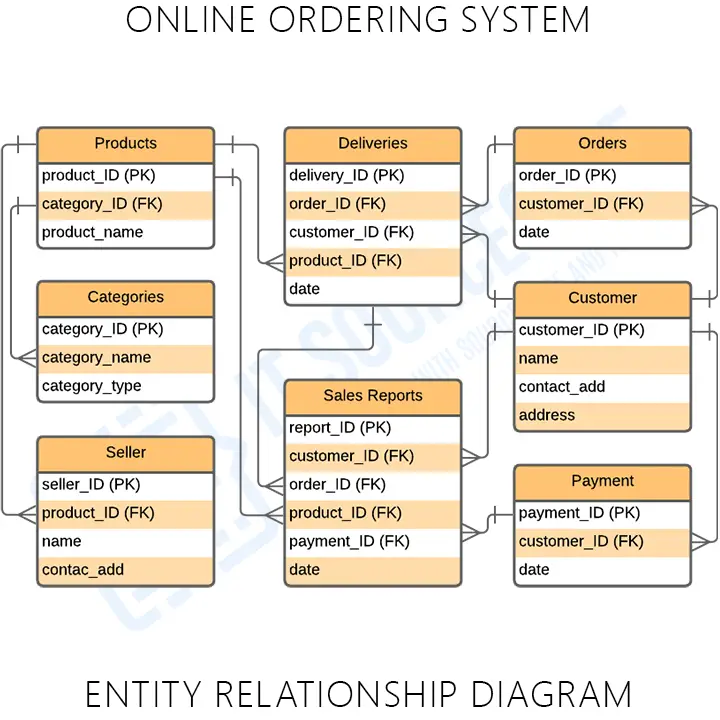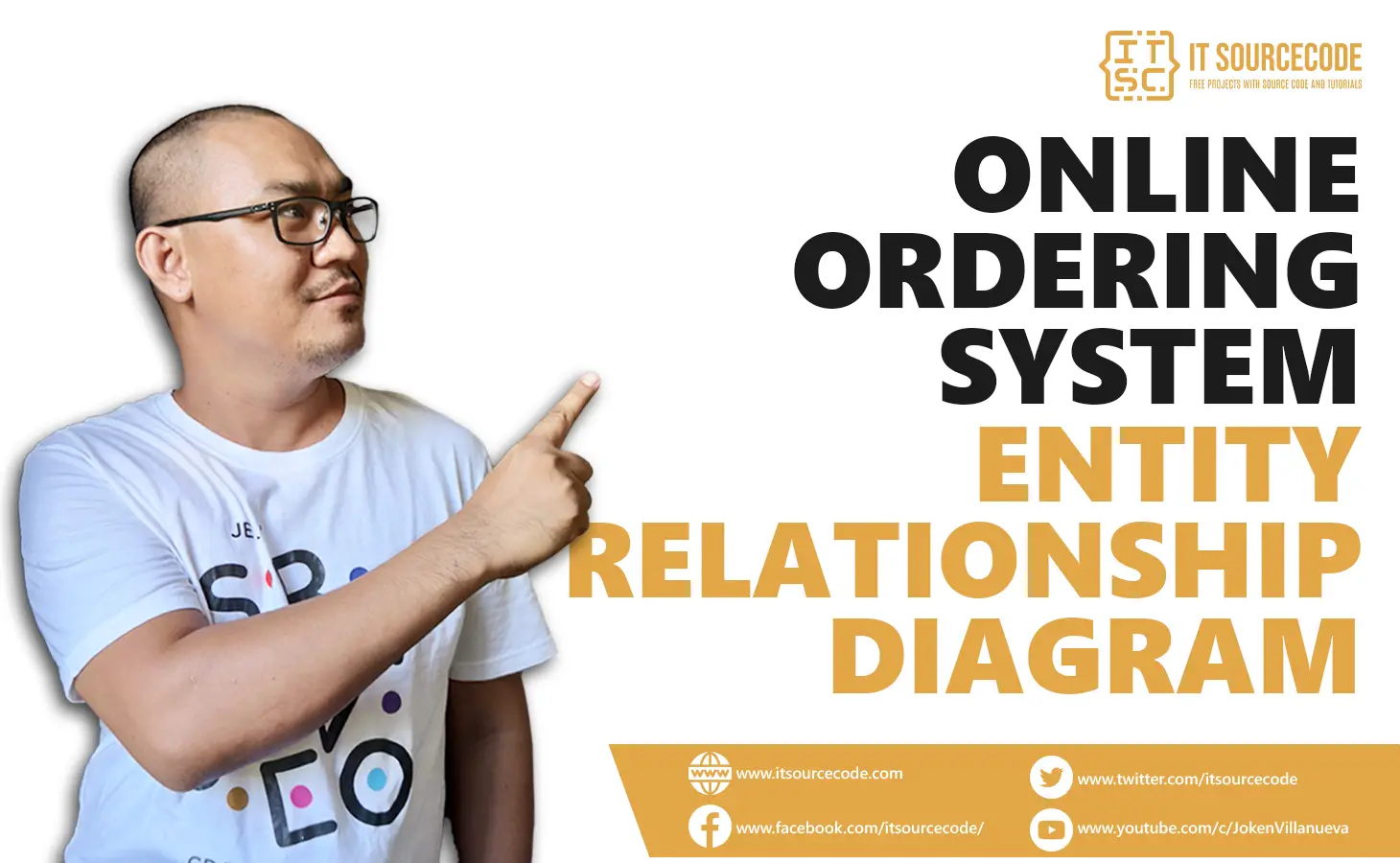The online ordering system’s entity relationship (ER) diagram translates system entities into a database. This describes the logical structure of the system’s database or data storage. It is done by identifying the online ordering process entities, their properties, and the interactions between them.
The database design is sketched out using online ordering system ER diagram. This database sketch becomes the actual basis of the system’s data storage that will serve as data and source.
Online Ordering System ER Diagram: Details
The table shows the overall description of the ER Diagram for Online Ordering System. It has a complete overview of the project’s information.
| Name: | Online Ordering System ER Diagram |
| Abstract: | The online ordering system ER diagram depicts the relationship between various entities. It can be thought of as a blueprint for your system (project) structure. |
| Diagram: | ER Diagram is also known as Entity Relationship Diagram |
| Tools Used: | Diagraming tools that provide ER diagram symbols. |
| Users: | Food Stand and Restaurant Owners and Customers. |
| Designer: | ITSourceCode.com |
What is an Online Ordering System?
The ordering system is the machine like aspect of inventory management. These are the programs that convert forecasts, actual orders, safety stock, and order quantities into purchase orders or production orders. A simple automated system lets your business accept online meal orders via a branded website or mobile app.
What is an ER Diagram?
The ER Diagram is referred to as the online ordering system database design. This ER Diagram is the graphical depiction of relationships between all the entities involved in the system. Its major components are Entities, Attributes, and Relationships.
Online Ordering System Database Design
The online ordering system database design was made based on online ordering requirements. The system can encode customer information. Online Selling admin can have access to the customer status and information for the important transactions. They can manage customer and product data and customer seller transactions.
Importance of ER Diagram
The importance of ER diagram for online ordering system is to help in modeling its data storage or database. The ER Diagram also describes how an entity interacts with other entities. All other real-world projects are presented with ER Diagrams (database designs). The online ordering system’s er diagram and data flow diagram illustrate a data store’s information and attributes.
Entity Relationship Diagram for Online Ordering System
ER Diagram of Online Ordering System shows the system entity relationships in each entity and their supposed functions in each relationship.

The online ordering system database’s ER diagram includes tables for seller, customer, products, categories, orders, delivery, payment, and sales reports. The tables meet the system’s requirements and provide detailed information about each entity.
Online Ordering System ER Diagram Tables
These tables below provide the complete database table details such as Field Name, Descriptions, data types, and character lengths. Each of these tables represents the characteristics and the attributes of data storage.
Field provides each database’s properties, description explains each, type lists their data type, and length lists their character lengths.
Table Name: Customer
| Field | Description | Type | Length |
| customer_ID (PK) | Customer ID | Int | 11 |
| name | Customer Name | Varchar | 255 |
| contact_address | Customer Contact | Int | 11 |
| address | Customer Address | Text | |
| Customer Email | Varchar | 255 |
Table Name: Categories
| Field | Description | Type | Length |
| category_ID (PK) | Category ID | Int | 11 |
| category_name | Category Name | Varchar | 255 |
| category_type | Category Type | Varchar | 255 |
Table Name: Orders/Reservation
| Field | Description | Type | Length |
| order_ID (PK) | Order ID | Int | 11 |
| customer_ID (FK) | Customer ID | Int | 11 |
| order_date | Date of Order | Date |
Table Name: Deliveries
| Field | Description | Type | Length |
| acc_ID (PK) | Account ID | Int | 11 |
| customer_ID (FK) | Customer ID | Int | 11 |
| delivery_date | Date of Delivery | Date |
Table Name: Products
| Field | Description | Type | Length |
| product_ID (PK) | Product ID | Int | 11 |
| category_ID (FK) | Category ID | Int | 11 |
| product_name | Product Name | Varchar | 255 |
Table Name: Seller
| Field | Description | Type | Length |
| seller_ID (PK) | Seller ID | Int | 11 |
| product_ID (FK) | Product Name | Int | 11 |
| seller_name | Seller Name | Varchar | 255 |
Table Name: Payment
| Field | Description | Type | Length |
| payment_ID (PK) | Payment ID | Int | 11 |
| customer_ID (FK) | Customer ID | Int | 11 |
| payment_date | Date of Payment | Date |
Table Name: Sales Report
| Field | Description | Type | Length |
| report_ID (PK) | Report ID | Int | 11 |
| customer_ID (FK) | Customer ID | Int | 11 |
| order_ID (FK) | Order Id | Int | 11 |
| product_ID (FK) | Product Id | Int | 11 |
| payment_Id (FK) | Payment Id | Int | 11 |
The tables given will be the basis for developers on how would they design the online ordering database. It contains the whole database description and will be stored in the software along with the table names. They will create a database with the attributes given as well as the value of each attribute.
Online Ordering System ER Diagram [PDF]
The ER Diagram for Online Ordering System PDF provides the information explaining the concepts of the project database. You may apply this information to your capstone project. You can also use it directly or modify its content depending on your project’s requirements.
How to create ER Diagram
Time needed: 5 minutes
Steps in building the ER Diagram for Online Ordering System with Cardinality Ratio.
- Step 1: Familiarize the ER Diagram (Entity Relationship Diagram) Symbols
Entity Relationship Diagram – shows the structure of data types in a project. It uses symbols to clarify its parts and relationships. Their symbols and applications must be familiarized before you build the ER Diagram.
ER Diagram Symbols:
• Fields: Fields are the parts of a table that define the entity’s characteristics. In the database that the ERD models, attributes are commonly thought of as rows.
• Keys is a technique to categorize data qualities. It is used to organize ER diagrams and assist users in modeling their databases to ensure that they are efficient. This is also used to connect different tables in a database.
– Primary Key: identifies a single entity instance which means a unique attribute or set of attributes.
– Foreign Key: is produced when data attributes have one too many relationships with other entities. - Step 2: Finalize the entities included
Start designing your ER Diagram by finalizing the entities that must be included in your online ordering system. Leave plenty of room in future phases to add this rectangle to your design.
- Step 3: Add the attributes of each entity
After finalizing the entities, think about the qualities you’ll need to characterize each entity. The details of the various entities outlined in a conceptual ER diagram are supplied as attributes. Characteristics of an entity, a many to many relationship, or a one to one relationship are all examples of attributes. Multivalued attributes can be assigned to several values.
- Step 4: Describe the relationships between entities and attributes
At the connector’s endpoints, the cardinality is indicated by a crow’s foot. One-to-one, one-to-many, and many-to-many are the three most common cardinal relationships. It’s the maximum number of times an instance of one entity can be linked to instances of another entity.
Conclusion:
You need to know the diagrams used to design and develop the Online Ordering System. That is to help you create a fully-functional system with the use of ER Diagram. Creating it will help you perceive the back end of the software. This will hold all the data that’ll enter and exit the system.
Related Articles:
- ER Diagram for Bank Management System
- ER Diagram for Hotel Management System
- ER Diagram for Student Management System
- Loan Management System ER Diagram
- ER Diagram for Online Shopping System
Inquiries
If you have inquiries or suggestions about the ER Diagram for Online Ordering System, just leave us your comments below. We would be glad to know to concerns and suggestions and be part of your learning.
Keep us updated and Good day!

